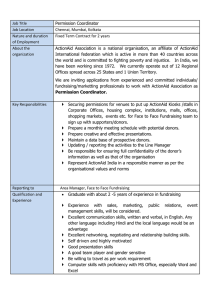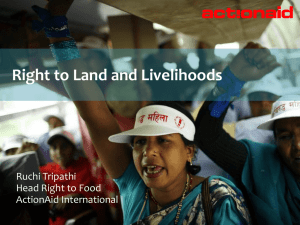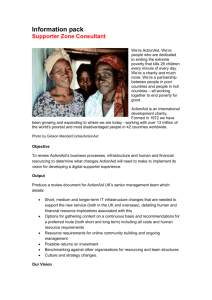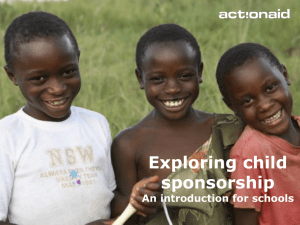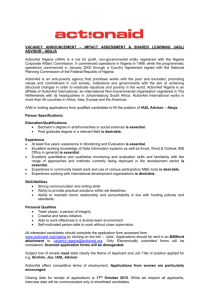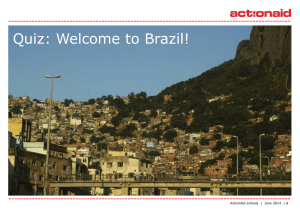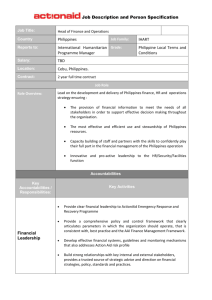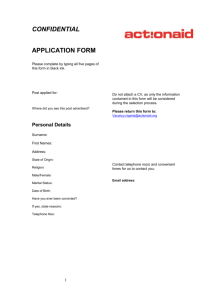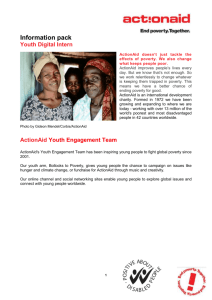Saving Lives, Protecting Rights
advertisement
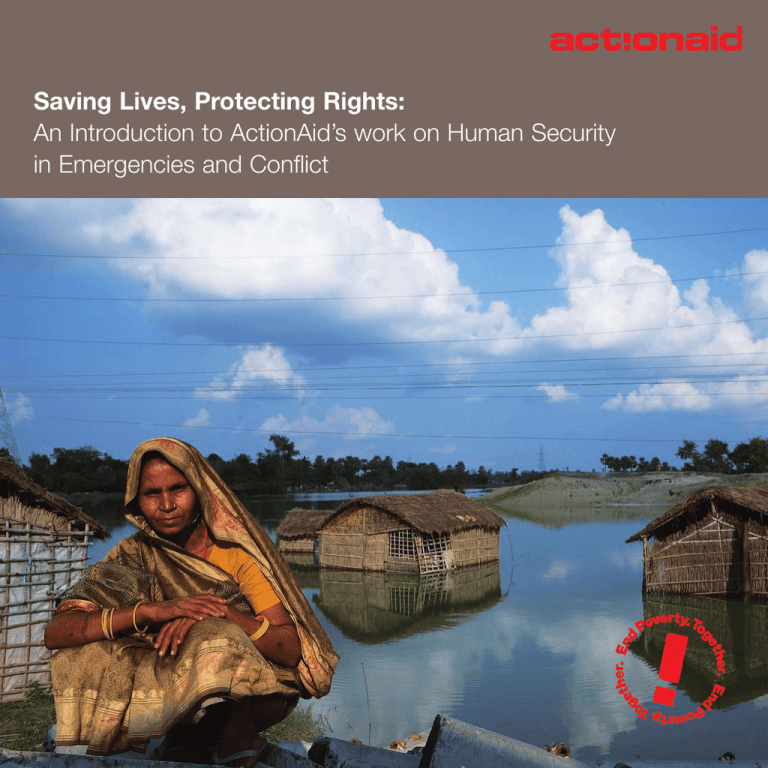
Saving Lives, Protecting Rights: An Introduction to ActionAid’s work on Human Security in Emergencies and Conflict About ActionAid ActionAid is an International NGO which respects, promotes, protects and works to fulfil, the rights of poor and excluded people around the world, by focusing on their empowerment and active participation in the design and implementation of our programmes. We provide assistance to people based on their needs and capacity, regardless of their identity, gender or beliefs. We advocate for states, national governments and other powerful institutions to recognise and fulfill their responsibilities to protect and empower all of their citizens, whoever and wherever they are. ActionAid’s approach to human security in emergencies and conflict: saving lives, protecting rights The Human Security concept, developed originally by the UN, puts poor people at the centre of perceptions and analysis and focuses on the issues they cite as important. ActionAid’s experience in emergencies and conflict has grown considerably over the last 10 years, and we have responded quickly and effectively to numerous recent large-scale humanitarian disasters. Accordingly, we have adopted human security in emergencies and conflict as one of our six core areas of work, with three main strands: disaster risk reduction, emergency response and conflict. This comprises: national and global policy work to address the root causes of natural and human-made disasters (including conflict); pre-disaster preparedness work to enhance the resilience of vulnerable communities; and post-emergency relief, rehabilitation and recovery programmes. Key facts Our vision is a world without poverty and injustice in which every person is able to fulfil their right to a life of dignity. Formed in 1972 in the UK, we now work in over 45 countries in Africa, the Americas, Asia and Europe. In 2003, we established our head office in South Africa and began the process of making all our country offices equal partners in our governance. 89% of ActionAid staff and the vast majority of our senior managers come from developing countries. ActionAid’s 2006 income was €178.1m, of which €22.8m was raised for our emergencies work. ActionAid reaches out to over 25 million poor people globally. Delivering efficiently and effectively Within ActionAid, the highly experienced International Emergencies and Conflict Team (IECT) acts as a central resource providing support to our country programmes to improve the quality and impact of their work. The team consists of six regionally-based, multidisciplinary advisors who build the emergency response capacity of country programmes before disasters and are deployed in the event of a major disaster. The team has additional expertise in ActionAid workers distribute tarpaulins, mosquito nets, and plastic sheeting to villagers suffering the effects of flooding in Katakwi District, Eastern Uganda Vincent Ojumbo Wandera/ActionAid policy analysis, advocacy, communications and fundraising, and is responsible for developing approaches to keep ActionAid at the cutting edge of this work. Lessons learnt from past emergency and conflict work are factored into future responses. Specialised experience in providing community based psychosocial support (particularly to IDPs and female victims of violence), disaster risk reduction & preparedness programmes and livelihood recovery programmes focused on reducing vulnerability. 1) The Alert System – a colour coded system for categorising emergencies during their onset and peak which triggers standardised fundraising, communications and operational response actions across the organisation. 2) The Emergency First Action Support Team (E-Fast), a pool of experienced and skilled AA staff from various country programmes who can be quickly deployed for response, supplementing the work of IECT staff. International expertise and policy analysis on humanitarian issues drawing experience from the communities we work with to influence policy and practice locally, nationally and internationally. Priority areas include disaster risk reduction and adaptation to climate change, conflict and peace building, food aid and UN humanitarian reform. 3) The Emergencies Alert, Review and Response Mechanism (EARARM), to enhance our organisational preparedness by proactively analysing the capacity, resources and partners needed to undertake a response to likely disasters. 4) The Strategic Crisis Programme which allows immediate disbursement of funds to country programmes for rapid or slow onset humanitarian responses or initiating other strategic areas of work. Additionally, we have focal people in each country programme with a remit to work on disaster risk reduction and emergency and conflict response, and over 2,000 grassroots partners globally, ready to work with ActionAid when an emergency hits or in a conflict situation. What ActionAid offers A rights-based approach that puts poor and excluded people at the centre of responses and analyses the dynamics of power, inequality and discrimination. Conflict-sensitive programming that ensures that our relief, recovery and rehabilitation work does not exacerbate existing tension. ‘ ActionAid has played a pioneering role in incorporating disaster risk reduction into its national, sub-national, sectoral and community initiatives and has facilitated the development and introduction of the Hyogo Framework as a component. ’ UN Sasakawa Award Jury, on awarding ActionAid a certificate of distinction for disaster risk reduction work, October 2007 Programmes designed to reinforce the local capacities and resilience of the communities we work with; at the same time seeking to increase the capacity of people and institutions responsible for emergency preparedness and response. Recognition of the importance of local knowledge and a strategy to work in partnership with local communities, civil society organisations and social movements, and to build their capacity and profile. Rigorous and effective participatory methodologies for conflict analysis and vulnerability analysis ensuring that all our responses are appropriate, community-led and transparent. An ActionAid partner organisation employee consults with the local community on sanitation issues in Madhubani Ghat, India, during the 2007 floods Jacob Silberberg/Panos/ActionAid A focus on women and children, people with disabilities, and the elderly, recognising that they are often hit hardest by disasters and can be the most marginalised in relief, peacebuilding and rehabilitation efforts. Using emergency situations as an opportunity to address longer-term development needs as well as using on-going development work to enhance community resilience to emergencies. Promotion of quality programming in adherence to International Humanitarian Law and internationally agreed standards including Sphere and the Red Cross Code of Conduct. Innovative mechanisms for accountability and transparency through ActionAid’s Accountability, Learning and Planning System. This provides a framework for involving communities and partner organisations closely in the planning, budgeting, monitoring and reviewing of programmes, and focuses on ensuring accountability to the people we work with. ‘ Perhaps the most complete and strategic approach to accountability was by ActionAid, which has put in place mechanisms for enhanced accountability to beneficiaries and the community in the form of social audit and community reviews… ActionAid is also very much focused on rights and advocacy and hence it may give greater priority to accountability than other agencies. DEC Independent Tsunami Evaluation Team, January 2006 ’ Participatory Vulnerability Analysis (PVA) – the analytical tool that empowers PVA is a versatile programme tool developed by ActionAid over more than ten years. A PVA exercise involves a community in an in-depth examination of its vulnerability to local hazards and examines what different groups can do to reduce risks. PVA aims to involve responsible government bodies and other relevant stakeholders in the analysis and follow-up, and regularly informs the design of ActionAid and partner programmes and advocacy around the world. The tool’s strength lies in its potential to link local opinions and ideas with high level policy decisions by providing an outline structure for analysis and local advocacy strategy. ‘ …we applaud the participatory focus of ActionAid’s Participatory Vulnerability Analysis tool ’ UK International Development Committee, Seventh Report 2005-6 ‘Humanitarian response to natural disasters’ ActionAid international memberships/partnerships UN International Strategy for Disaster Reduction (UNISDR) – board member/ inter-agency group on education and disaster reduction Inter Agency Standing Committee – task force member on mental health and psychosocial support in emergencies Research and publications Recent publications cover issues of climate change adaptation, disaster risk reduction, post-tsunami human rights issues, UN humanitarian reform, UN Peacekeeping and its role in reducing violence against women. Full details and downloads, including the PVA guide, are available at www.actionaid.org International Council for Voluntary Agencies (ICVA) – executive committee member Sphere Project – board member Disasters Emergency Committee (UK) – member VOICE (European network of humanitarian agencies) – member Transparency International – partnership to develop practical guidelines to prevent corruption CAN (Climate Action Network) – member Recent institutional/appeal funded work Source of funds € million For UK Disasters Emergency Committee 46.9 Emergency response Indian Ocean tsunami (2004), Sahel food crisis (2005), Bangladesh Cyclone (2007) DfID/Greek Ministry 4.8 Disaster Risk Reduction DRR through schools in 9 countries (2006 – 11) ECHO 2.1 Emergency response Vietnam floods (2007), Bangladesh Cyclone (2007), Afghanistan heavy snow (2008) Conflict Psychsocial care and support, Indian-adminsitered Kashmir (2006 & 2007) ActionAid supporter appeals 2.1 Emergency response East Africa food crisis (2006), Asia floods (2007), Bangladesh Cyclone (2007) DIPECHO 1.6 Disaster Risk Reduction Bangladesh, Vietnam, Nepal, Cambodia, Afghanistan (2004 onwards) DANIDA 1.3 Post-Conflict Reducing violence against women, DRC, Burundi, Sierra Leone (2006 – 08) UN OCHA 0.4 Emergency Response Ethiopia floods (2006) ActionAid International Postnet Suite 248 Private Bag X31 Saxonwold 2132 Johannesburg South Africa Further information email: emergencies@actionaid.org tel: +44 (0) 20 75617538 web: www.actionaid.org AFGHANISTAN PAKISTAN NEPAL INDIA BANGLADESH HAITI/DOMINICAN REPUBLIC GUATEMALA BURKINA FASO NIGER THAILAND THE GAMBIA SOMALILAND NIGERIA SIERRA LEONE ETHIOPIA LIBERIA GHANA UGANDA RWANDA BURUNDI VIETNAM DRC SRI LANKA MALDIVES INDONESIA KENYA TANZANIA MALAWI ZAMBIA MOZAMBIQUE ZIMBABWE Cover: CONFLICT NATURAL DISASTER DISASTER RISK REDUCTION Urmila Devi, aged 55, sits in front of flooded farmland and abondoned huts after her home was swept away by floods in Muzzafarpur District, India. Sanjit Das/ActionAid.
